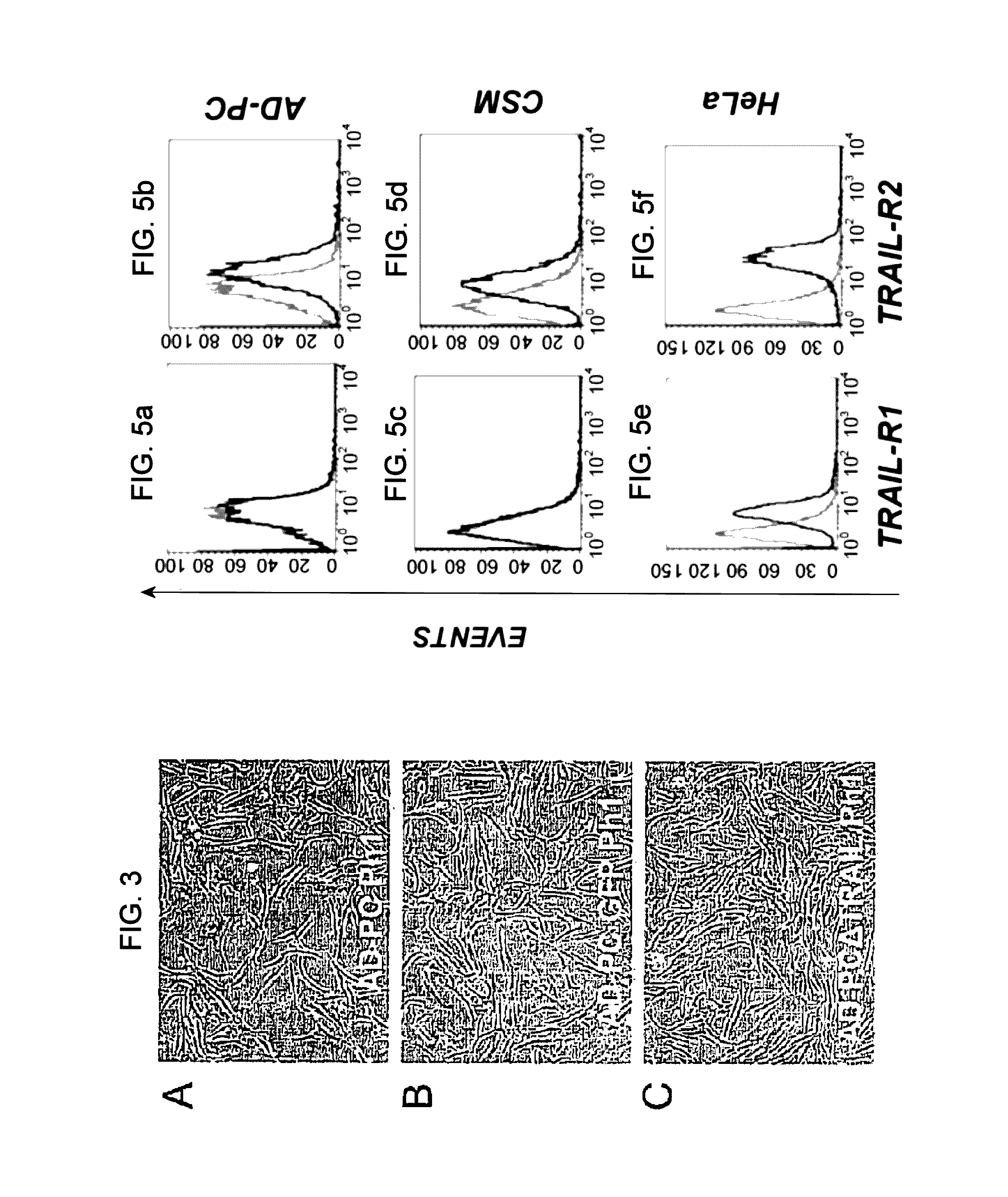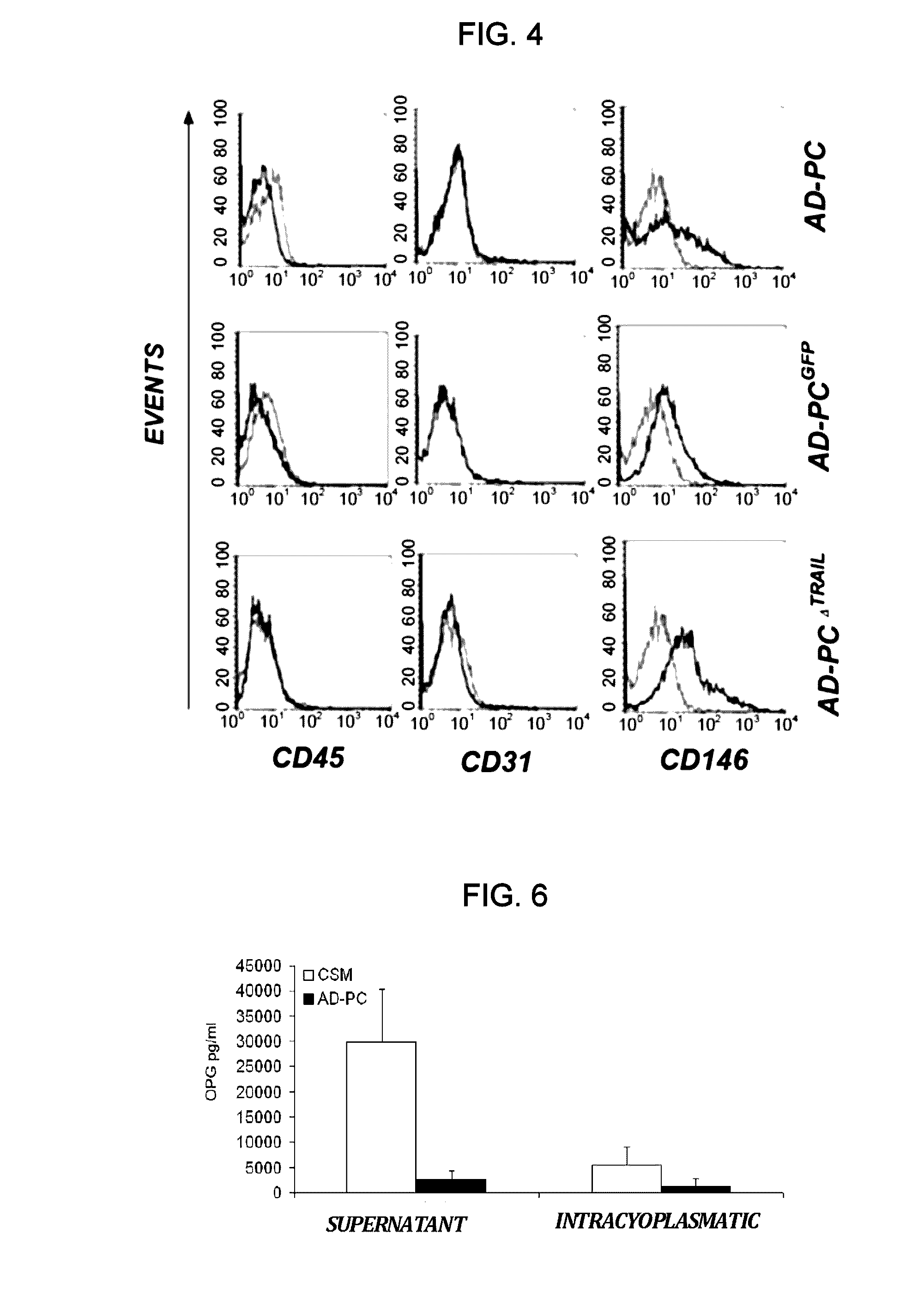Method for production of anti-tumor TRAIL protein
a production method and antitumor technology, applied in the field of antitumor trail production, can solve the problems of unsatisfactory increased overall costs, and inability to meet the needs of repeated trail administration, and achieve substantial cost-effective trail administration and limit undesired side effects of organisms
- Summary
- Abstract
- Description
- Claims
- Application Information
AI Technical Summary
Benefits of technology
Problems solved by technology
Method used
Image
Examples
example 1
[0084]Isolation of pericytes from Vascular Stromal Fraction (VSF), immunophenotype characterization and gene modification: AD-PC cells were isolated from liposuctioned fat of healthy individuals through enzymatic digestion. The protocol includes processing of adipose tissue with a collagenase-based enzymatic solution. The buffer in which the lyophilized enzyme is resuspended is composed of the Low Glucose DMEM Medium (Dulbecco Modified. Eagle's Medium, Euroclone) supplemented with 1% penicilline / streptomicine (PAA, Laboratories GmbH). Adipose tissue is incubated in the enzymatic solution at 37° C. Then, 1500 rpm centrifugation is applied for 10 minutes and the cell pellet is resuspended in Low Glucose DMEM supplemented with 10% FBS (Foetal Bocine Serum, PAA, Laboratories GmbH) and 1% penicilline / streptomicine. The adipocytes left in the suspension are eliminated using a filter having 100 μm porosity (Cell Strainer, BD Falcon) and the filtrate is centrifuged at 1500 rpm for 10 minute...
example 2
[0114]Evaluation of the cytotossic effect of ΔTRAIL on tumor cells: HeLa tumor cells were seeded in 24 well plates at a concentration of 6×103 / well in triplicate 24 hours before the assay.
[0115]The supernatant, that was left in contact with AD-PCΔTRAIL or AD-PCGFP cells for 4, 24 and 48 hours was collected to replace the medium in the wells in which the tumor cells had been seeded. Cell viability and necrosis were assessed after 4, 24 and 48 hours by propidium iodide staining (50 μg / ml) followed by cytofluorimetric analysis. As a positive control, the same tumor cells, under the same conditions, were placed in contact with 20 ng / ml recombinant soluble human TRAIL protein (Peprotech, Rocky Hill, N.J.).
[0116]Caspase-8 activation assay: the activation of caspase-8, an enzyme involves in TRAIL-mediated early pro-apoptotic pathway is assessed as follows: HeLa tumor cells are put in contact with the supernatant collected from AD-PCΔTRAIL. A negative control is also prepared, which consist...
example 3
[0123]Assessment of the in vivo anti-tumor effect of AD-PCΔTRAIL cells: for in vivo studies, eight-ten week NOD.CB17-Prkdcscid / J mice were used, according to the guidelines of experimental protocols (Prot. / n.543) approved by the ethic committee on animal experimentation of the University of Modena and Reggio Emilia. 2×105 HeLa in 200 μl di PBS were subcutaneously administered to the animals. The tumor disappeared about two weeks later, its size being constantly monitored by means of a tumorimeter. Tumor volume was calculated using the formula: volume=length×height2 / 2.
[0124]As the tumor appeared, the mice were divided into three groups, each consisting of three mice, the animals of the group A (control group) underwent additional handling or even weekly evaluation of tumor mass and weight growth, the animals of group B underwent three successive administration hits, by injection of 1×106AD-PCGFP resuspended in 200 μl PBS into the lateral tail vein, the animals of group C underwent th...
PUM
| Property | Measurement | Unit |
|---|---|---|
| concentration | aaaaa | aaaaa |
| size | aaaaa | aaaaa |
| resistance | aaaaa | aaaaa |
Abstract
Description
Claims
Application Information
 Login to View More
Login to View More - R&D
- Intellectual Property
- Life Sciences
- Materials
- Tech Scout
- Unparalleled Data Quality
- Higher Quality Content
- 60% Fewer Hallucinations
Browse by: Latest US Patents, China's latest patents, Technical Efficacy Thesaurus, Application Domain, Technology Topic, Popular Technical Reports.
© 2025 PatSnap. All rights reserved.Legal|Privacy policy|Modern Slavery Act Transparency Statement|Sitemap|About US| Contact US: help@patsnap.com



